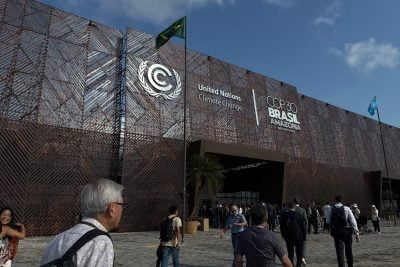Africa’s energy sector is emerging blinking into the light after a tumultuous three years in which the impact of a global pandemic and an energy security crisis sparked by Russia’s invasion of Ukraine hit the incomes of the poorest people, sent energy costs spiralling upwards and staunched investment flows.
The good news is that a continent blessed with copious renewable energy resources – especially solar power – should be well placed to benefit from the global build-up of a new wave of investment in clean energy technology.
“Clean energy is moving fast – faster than many people realise. This is clear in the investment trends, where clean technologies are pulling away from fossil fuels,” International Energy Agency executive director Fatih Birol said on launching the IEA’s World Energy Investment Report in May.
“For every dollar invested in fossil fuels, about 1.7 dollars are now going into clean energy. Five years ago, this ratio was one-to-one. One shining example is investment in solar, which is set to overtake the amount of investment going into oil production for the first time,” he said.
As ever, Africa’s need to win a share of this global investment is pressing, given the urgent need to speed up efforts to achieve universal access to electricity across the continent. Despite considerable progress over the last two decades, there is still a long way to go. Just over half of the population of sub-Saharan Africa still has no electricity access, a figure that rises to more than 70% for those in rural areas, according to recent World Bank data.
Read more about energy in Africa
Private funding is flowing
There is optimism that Africa’s huge renewable energy resources can make real inroads into overcoming the continent’s energy shortfall, as industrial supply chains recover after the pandemic and technology costs fall.
Crucially, parts of Africa are no longer pioneering territory for renewables developers. Countries such as Egypt, Morocco, South Africa, Senegal and Kenya play host to significant solar and wind developments. Their track records are helping to de-risk more of the continent for investors.
Support from multilateral development banks (MDBs) and development finance institutions (DFIs) still underpins investment in many types of energy project across much of Africa, but private funding is flowing, even if it is more evident in some parts of Africa than others.
This is partly driven by the increasing sophistication of African-grown clean energy firms and other low-carbon businesses, which provide ever-improving investment opportunities, as well as a growing network of African-based lenders, specialist funds and other financial sector institutions that know where best to direct investment.
Another driver is the use of innovative international lending mechanisms, such as blended finance initiatives, in which cheap financing and guarantees from MDBs and DFIs are designed to provide a more secure platform for private investment.
Not everyone thinks that DFI funding is making the expected difference in stimulating private investment, especially in some poorer African countries, where solar power is struggling to scale up. Governments are too poor to add to the momentum provided by DFIs, while consumers are too poor to pay for even relatively cheap electricity. The hope is that falling costs will make renewable power affordable to more people over the next few years.
Platform for growth
In the past, some governments regarded renewable energy development as an impediment to economic growth, rather than an aid. They were suspicious of what they regarded as efforts by developed countries to foist costly green technologies onto countries that could not afford them and would benefit little from them economically. That view is changing.
Costs are now on a par with fossil fuels in many parts of Africa and it is becoming clearer how countries can leverage renewables potential to stimulate the wider economy, moving beyond just getting the lights, heating, air conditioning, stoves and fridges to work.
The International Renewable Energy Agency (IRENA) estimates that if Africa pursues an ambitious energy transition pathway, more than 12m new transition-related jobs could be created across Africa in 2019-30, with an additional 3m by 2050 – most of them in renewables, energy efficiency, electricity grids and energy storage. These would more than offset the loss of around 2.2m jobs in the fossil fuels industry by 2050. Millions of further jobs would then be created by the boost to the wider economy – the energy transition has the potential to be a vote-winner for governments.
One key factor in attracting investment to large-scale solar and wind projects is providing commercial energy off-takers with the flexibility to use surplus intermittent renewable power when it is not needed elsewhere. Another is building renewable energy projects dedicated to powering specific industrial projects. Egypt is the North African leader in this, building some of the continent’s largest solar farms to power hydrogen production for fertiliser plants and other infrastructure in its industrial zones close to the Suez Canal.
At the other end of Africa, South Africa is plotting a similar course, but has the added task of completely revamping its power infrastructure as it seeks to reduce its over-dependence on coal-fired power stations for supply. That task is progressing, albeit slower than renewable energy developers would like. They say red tape is slowing the roll-out of solar projects and that this is contributing to power shortages triggered by failures in the country’s creaking coal-fired power infrastructure.
The energy transition also presents wider opportunities for jobs and the economy. Africa is home to some of the key minerals, such as cobalt, on which the manufacture of batteries for electric vehicles (EVs), phones and much other technology depends. The attractions of developing EV and battery manufacturing on home soil, rather than just exporting raw materials without any added value, are obvious. Whether the required investment will be forthcoming outside of Africa’s more developed economies remains to be seen.
In one attempt to kick-start manufacturing, the Democratic Republic of Congo and Zambia are hoping to develop EV and battery manufacture in special economic zones under an agreement with the African Export-Import Bank (Afreximbank) and the United Nations Economic Commission for Africa.
Hydrocarbon production boost
African countries with hydrocarbon resources are also on the other side of the energy equation from power consumers. While energy importers struggled to foot spiralling fuel bills during the hydrocarbons price hike triggered by the Ukraine war, African oil and gas exporters could sell their products for more and found potential investors eyeing their hydrocarbon reserves more favourably.
Namibia, so long seen as a backwater struggling to drum up interest in exploration and production, has become an investment magnet for the oil majors following sizeable discoveries in recent years. Mozambique started liquefied natural gas (LNG) exports in November 2022, and Mauritania and Senegal are set to join the hydrocarbon producers’ club in the coming
months.
However, it is far from plain sailing for African oil and gas producers, as foreign firms and their home government backers carefully review lending to the sector in light of green energy targets and environmental social and governance (ESG) requirements. For example, the future of Mozambican LNG projects and the East African Crude Oil Pipeline (EACOP) oil pipeline from Uganda to the Tanzanian coast currently hang in the balance due to finding uncertainties.
Those countries with gas reserves now face the choice of how to maximise their economic benefit. In practice that means a focus on exports, while also using some of the gas for much-needed domestic power generation and lucrative industrial processes.
Here, sustainable development is the mantra, which means a measured approach to developing domestic gas usage to help economic growth alongside spending on renewable energy and related industries. Mauritania exemplifies this balancing act: it is set to become a gas exporter from its offshore resources this year, while pushing to develop gas-feedstock based industries, such as ammonia production, as well as a green hydrogen industry, powered by its abundant solar power resources.
Traditional producers remain top exporters
Longer-established oil and gas producers, such as Angola, are also benefiting from the hunt for alternatives to Russian hydrocarbons, though here the focus is more on getting the most out of developments close to existing offshore energy infrastructure, rather than on frontier developments.
Nigeria is still vying with Angola and Algeria to be the continent’s leading oil producer, despite fluctuating production levels in recent times. In deep water, Shell and TotalEnergies continue to develop their Bonga and Egina projects, respectively. Meanwhile, local companies are trying to rejuvenate production in the shallow waters around the Niger Delta, now the majors have moved on.
The inauguration of Bola Tinubu as Nigeria’s president at the end of May raised hopes that the country’s foreign investment climate may improve. Tinubu is credited with facilitating the economic renaissance of Lagos, where he was governor. He has also scrapped fuel subsidies, long seen as a prerequisite for a revamp of the country’s energy sector.
The challenges of the energy transition are substantial wherever you are in the world, and they are made all the more complex in Africa by poverty, lack of infrastructure and patchy investment. But there is no shortage of determination to make the clean energy revolution happen on the continent in a way that enhances economic growth and benefits everyone.
Want to continue reading? Subscribe today.
You've read all your free articles for this month! Subscribe now to enjoy full access to our content.
Digital Monthly
£8.00 / month
Receive full unlimited access to our articles, opinions, podcasts and more.
Digital Yearly
£70.00 / year
Our best value offer - save £26 and gain access to all of our digital content for an entire year!

 Sign in with Google
Sign in with Google 



